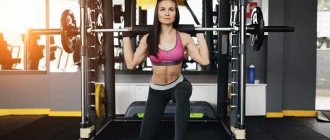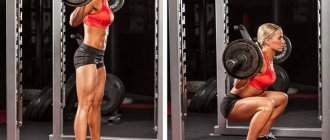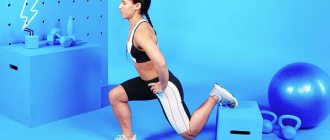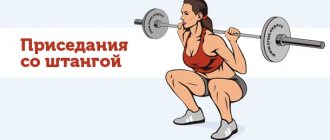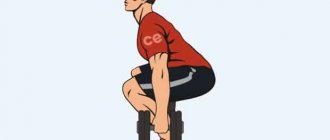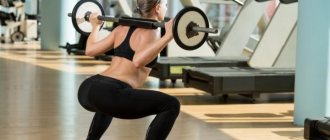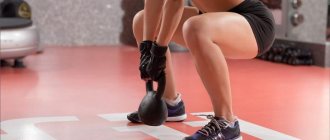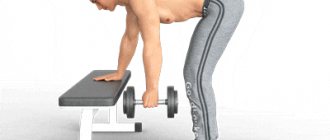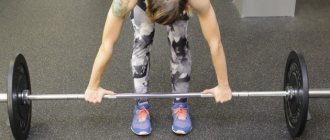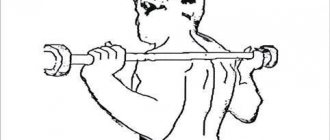The leg muscles are key to gaining muscle mass. Scientists have long proven that only basic leg exercises can stimulate the body to release the maximum amount of natural testosterone.
Basic exercises are considered to be various types of squats with a barbell or dumbbells, which involve more than two joints. And if a beginner needs only the usual classic squats with a barbell on his shoulders, then more advanced athletes think about the correct drawing of the muscles on their legs.
To pump up your quadriceps, you can use an exercise such as front squats. Few people do them because of the difficulty of performing them, since not everyone manages to hold the barbell and arms in the correct position. But for those who have mastered this art, pumping up the quadriceps is easier than others.
What barbell grips can I use?
There are two most common grips used when performing front squats.
The first one is the palms up grip. It allows you to firmly grasp the barbell and makes it possible to control its movement throughout the entire time of performing squats. But there is also a drawback - you need to have a certain flexibility, since this position of the hands, when the elbows and palms look up, cannot be comfortable for everyone.
The second grip is more universal and suitable for any person. With the barbell on your shoulder, cross your arms and touch them to the opposite shoulder. That is, the right hand should touch the left shoulder, and vice versa.
Variations of the exercise
There are several ways to perform a front squat with a barbell. In addition to the classic technique, other options are also common:
- Deep squats with a barbell on the chest. Allows you to focus on the quadriceps and upper back. When performing, it is necessary to straighten the torso, which reduces the flexion of the lower back. As a result, the stability of the hull increases.
- Place your hands crosswise on your chest. When using a cross grip, the bar is held on the shoulders and upper chest. The limbs are extended forward, the right elbow is bent so that it rests on the left shoulder. Left hand on the right shoulder.
- Squats with dumbbells. The exercise is suitable for the fair sex who are not looking to gain weight, but are trying to keep their legs in good shape. In addition, the method is relevant for beginner athletes. Sports equipment is held with a normal grip without crossing your arms. The palms should be directed upward, the elbows should not be spread out to the sides.
- In Smith. The special machine is designed for the same actions as in a power frame. Thanks to the simulator, movements will be safe and controlled. The design holds the bar in place and reduces the risk of injury.
In each type of squats, the working muscles will be different, so choosing the appropriate option depends on your goals. Experts recommend practicing in front of a mirror to monitor the correct technique used.
Deep squat
With a kettlebell or dumbbells
With arms in a criss-cross position
In the Smith machine
Arch your back and squeeze your shoulder blades
Then step away from the racks and place your feet shoulder-width apart or slightly narrower. Other racks will force you to lean forward, which can affect the stability and position of the barbell.
The back should be absolutely flat, and the shoulder blades should be drawn inward. Front squats require special attention to posture. If you perform them with a round back, then the wrong muscles will be used that are supposed to work. Plus, the risk of injury increases.
When starting to squat, make sure that your elbows are above the bar, otherwise you will not be able to hold it and it will fall to the floor. Try to squat until parallel to the floor, and only then begin to rise up. Do 10-12 repetitions in this manner for 3-4 sets. Try to keep your knees open outward during the squat, otherwise the knee joint will be significantly loaded with the weight of the barbell.
Execution technique
Let's move on to a review of the technique of performing front squats with a barbell. But don't rush to hang your pancakes. As with any other exercise, there are still pitfalls.
There is a lot of detail about the technique in the video, be sure to watch it!
Preparing for the exercise
The experience of athletes shows that it is best to start leg and back training with hyperextension as a warm-up exercise . Hyperextension is recommended for those who experience discomfort in the lower back, thoracic and cervical regions. Another advantage is that there is no axial load when performing it. Don't go too low, we work on the back extensors without involving the hamstrings and buttocks. Make sure your back is not the weak link. If your back muscles are lagging behind in development, you will lose in all movements, from squats, standing barbell presses, and ending with bent-over rows.
Any exercise, and front squats with a barbell are no exception, should be started with warm-up approaches. This will not only increase the amount of stress received, which in turn will stimulate growth, but will also minimize the risk of injury. Warm-up approaches allow you to feel your muscles as much as possible and prepare yourself for work.
Remember, no matter what record weights you have, we start with an empty bar! Sports longevity is very important in our favorite activity.
Ready to get started? Are you eager to fight? There is one more condition. Shoes are also very important. Without the necessary rigidity of the sole, the technique will suffer, and therefore the result. Avoid soft shoes! Weightlifting weights are ideal. It is preferable to choose the heel height according to yourself; test several models. For those who suffer from flat feet, weightlifting is the optimal way out of the situation.
Let's move on to execution
We adjust the power frame based on your height. We ensure that the bar is at shoulder level. If there is no frame, then it doesn’t matter - we take the barbell to the chest as follows.
We bring our shoulders under the barbell. Hand position depends on experience and flexibility. The best option for a beginner is to hold the barbell with your arms crossed and keep your elbows parallel to the floor.
© Syda Productions - stock.adobe.com
More experienced athletes use a weightlifting style; some do not hold the barbell with their hands at all.
© milanmarkovic78 — stock.adobe.com. Holding a barbell in a weightlifting style
- Carefully move away from the racks, taking a step back, feet shoulder-width apart, toes pointing to the sides, watch your posture.
- We take a breath and slowly lower ourselves, don’t look down, push off with our heels. The required number of repetitions is behind us, carefully put the barbell in place.
© milanmarkovic78 — stock.adobe.com
Top 5 Tips for a Good Squat
Tips for those who want to perform front squats with a barbell effectively. Go!
- In order not to create excess intra-abdominal pressure and maintain a narrow waist when performing, wear a weightlifting belt. Hold your lower back firmly, but not too tightly.
- Before strength exercises such as front squats, it is best to eat food 1.5-2 hours before training.
- You need to be extremely careful when drinking liquid during training. You should not drink a lot, one or two sips between approaches. This will prevent you from feeling nausea and a full stomach.
- If after completing the approach you suffer from severe shortness of breath, the exercise is difficult to tolerate, it means that the mitochondria in your body are not sufficiently developed. You should think about doing additional cardio exercises.
- After completing the set, walk lightly. You should not run to the bench and transfer the load in this way. The heart is comparable to an engine! Flying 200 km/h, we do not brake instantly! How long will such a motor last?
What mistakes happen when athletes perform front squats with a barbell?
1. Shifting the center of gravity forward. There is no need to bend your body forward, as in classic squats. Considering that the bar is located in front of your body, this is not permissible.
2. Raised heels. Many people, when performing regular squats, prefer to slightly transfer everything onto their toes, raising their heels. When performing front squats, this should not be done, as this can lead to loss of balance and injury associated with the bar flying out and the athlete falling.
3. Crossed knees. Given the fairly close position of the legs in relation to each other, you need to carefully monitor the position of the knees. If, while performing, you see that your knees are approaching each other and bending inward, then stop doing the exercise immediately.
Front squat with dumbbells
This squat is much better than the classic squat for several reasons:
- – involves the largest number of core muscles;
- – this method allows you to squat much below parallel;
- – with this squat, the weight is better regulated.
There are several techniques for front squatting with dumbbells.
- You need to sit down as low as possible, you must not lift your heels off the floor and your back must be straight, you must bend your arms at the elbows and let the dumbbells touch your chest, you must create a load on your arms while holding the dumbbells suspended, you must place the dumbbells on the upper chest, holding them with your hands.
- The second option is similar to the first, the only difference is that the dumbbells should not be placed on the chest, but held on outstretched arms. The most important thing is to keep your back straight, otherwise your back may round.
There is also a third option for squats with dumbbells with a wide stance.
The essence of the exercise is that the legs should be placed wider than the shoulders, and the dumbbell should be held at outstretched arms. The rest is done exactly the same as in the first two options.
For the exercise of the previous option, you need one dumbbell and its weight should correspond to what you can hold.
The advantage of such exercises is stretching of all muscle groups involved.
Do not put unreasonable stress on the knee joint
The knees should move in the same plane as the feet. In this case, they should look forward and not lean left or right. Improper execution threatens to cause the knee joint to fly out of the cup, which is quite difficult to treat, and the injury remains for the rest of one’s life, weakening the person’s musculoskeletal system.
Dropping your elbows down is also a mistake. When performing front squats, the elbow joint should always be pointing upward to prevent the bar from simply rolling down. This is the most common mistake that leads to incorrect execution of the exercise.
What muscle groups are involved?
Front squats are used to work the outer quadriceps muscles. Due to the fact that the weight is in front of the body, the gluteal muscles are loaded much worse than in classic squats. This fact helps to better focus on the outer lateral and front parts of the leg muscles.
Try to feel these muscles throughout the entire range of motion. You should not specifically connect and involve other muscle fibers in the work - this will only interfere and dissipate the load on the rest of the body.
Difficult choice
What is better to do – front squats or classic squats? The answer to this question will be correct for each specific case. If the goal is to load the front of the legs and draw muscle definition, then it is better to do front squats. If you are interested in voluminous muscle growth and development of the back of the thigh, as well as the buttocks, then you need to perform classic squats.
Remember: when doing front squats or regular squats, you must always follow safety precautions and perform the exercise correctly. Do a good warm-up of your leg muscles and joints, always wear a lifting belt, and find a partner to help you with your squats. It is best if your partner is a gym instructor who can always correct your technique and give some practical advice.
And in pursuit of developing your quadriceps, never chase the weights you lift. It's better to do more repetitions or artificially slow down the movements to put more stress on your legs. Unreasonably increasing the weight of the barbell will not do anything good, but will only provoke muscle strain or cause injury to the knee joint.
What muscles work?
What muscles work during front squats with a barbell, let's find out in order to better understand their beneficial effect:
- Quadriceps;
- hamstrings;
- Gluteal muscles;
- Stabilizer muscles (abs, back, lower back);
- Calf;
- Hamstrings;
- Muscles of the back of the thighs.
